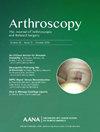有腰椎融合术病史的患者在初次髋关节镜手术后进行关节镜翻修和转为全髋关节置换术的风险较高。
IF 4.4
1区 医学
Q1 ORTHOPEDICS
Arthroscopy-The Journal of Arthroscopic and Related Surgery
Pub Date : 2025-02-01
DOI:10.1016/j.arthro.2024.08.026
引用次数: 0
摘要
目的:分析有腰椎融合史的患者接受初次髋关节镜手术后进行髋关节镜翻修或转为全髋关节置换术(THA)的风险:我们利用全州规划与研究合作系统(Statewide Planning and Research Cooperative System)这一包括纽约州(NY)所有门诊和住院手术病例的行政数据库,确定了 2010-2020 年间因 FAI 接受髋关节镜手术的所有患者。使用 CPT 和 ICD 第 9/10 次修订版编码定义确定了既往接受过腰椎融合术的患者。根据年龄和合并症负担,将既往接受过腰椎融合术和未接受过腰椎融合术的患者按 1:5 的比例进行配对。融合的水平数定义如下:i) 无融合,ii) 1-2 水平,或 iii) ≥3 水平。对患者进行为期两年的随访,以评估髋关节镜翻修率或转为 THA 的比率。多变量逻辑回归模型用于测量融合水平数与髋关节镜翻修或转为THA之间的关系:2010-2020年间,纽约州共有23277名患者接受了初次髋关节镜手术。其中,348人(1.4%)曾接受过腰椎融合术。在对年龄和合并症进行匹配后,既往接受过腰椎融合术的患者与未接受过腰椎融合术的患者相比,髋关节镜翻修或转为 THA 的复合率更高(16.5% 对 8.5%;P < 0.001)。这一风险随融合的水平数增加而增加(1-2个水平:15.1%;aOR,1.8;95% CI,1.3-2.6;与≥3个水平相比:26.3%;aOR,3.4;95% CI,1.7-7.0):结论:与无腰椎融合术史的患者相比,有腰椎融合术史的患者接受髋关节镜翻修手术和转为 THA 的比例明显更高。髋关节镜翻修或转为THA的风险在1-2级融合的患者中增加了约2倍,在3级或3级以上融合的患者中增加了3倍:III级,预后回顾性匹配比较病例系列。本文章由计算机程序翻译,如有差异,请以英文原文为准。
Patients With a History of Lumbar Fusion Have a Greater Risk of Revision Arthroscopy and Conversion to Total Hip Arthroplasty After Primary Hip Arthroscopy
Purpose
To characterize the risk of revision hip arthroscopy or conversion to total hip arthroplasty (THA) among patients with a history of lumbar fusion undergoing primary hip arthroscopy.
Methods
We used the Statewide Planning and Research Cooperative System, an administrative database including all ambulatory and inpatient surgery encounters in New York, to identify all patients who underwent hip arthroscopy for femoroacetabular impingement between 2010 and 2020. Patients with previous lumbar fusion were identified using Current Procedural Terminology and International Classification of Diseases, Ninth and Tenth Revision, coding definitions. Patients with and without previous fusion were matched in a 1:5 ratio according to age and comorbidity burden. The number of levels fused was defined in the following fashion: (1) no fusion, (2) 1-2 levels, or (3) ≥3 levels. Patients were followed for 2 years to evaluate the rate of revision hip arthroscopy or conversion to THA. Multivariable logistic regression models were used to measure the association between number of levels fused and revision hip arthroscopy or conversion to THA.
Results
Between 2010 and 2020, there were 23,277 patients who underwent primary hip arthroscopy in New York state. Of these, 348 (1.4%) had a previous lumbar fusion. After matching for age and comorbidities, the composite rate of revision hip arthroscopy or conversion to THA was greater in patients with previous lumbar fusion compared with patients without (16.5% vs 8.5%; P < .001). This risk increased with the number of levels fused (1-2 levels: 15.1%; adjusted odds ratio, 1.8; 95% confidence interval 1.3-2.6; vs ≥3 levels: 26.3%; adjusted odds ratio, 3.4; 95% confidence interval 1.7-7.0).
Conclusions
Patients with a history of lumbar fusion had significantly greater rates of revision hip arthroscopy and conversion to THA compared with patients without previous fusion. The risk of revision hip arthroscopy or conversion to THA was increased approximately 2-fold in patients with 1 to 2 levels fused and 3-fold in patients with 3 or more levels fused.
Level of Evidence
Level III, prognostic retrospective matched comparative case series.
求助全文
通过发布文献求助,成功后即可免费获取论文全文。
去求助
来源期刊
CiteScore
9.30
自引率
17.00%
发文量
555
审稿时长
58 days
期刊介绍:
Nowhere is minimally invasive surgery explained better than in Arthroscopy, the leading peer-reviewed journal in the field. Every issue enables you to put into perspective the usefulness of the various emerging arthroscopic techniques. The advantages and disadvantages of these methods -- along with their applications in various situations -- are discussed in relation to their efficiency, efficacy and cost benefit. As a special incentive, paid subscribers also receive access to the journal expanded website.

 求助内容:
求助内容: 应助结果提醒方式:
应助结果提醒方式:


